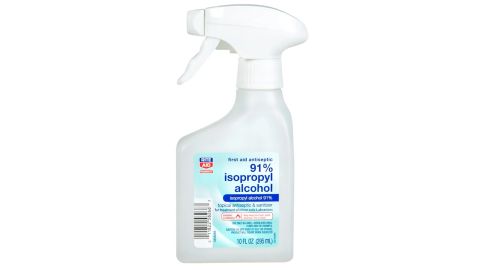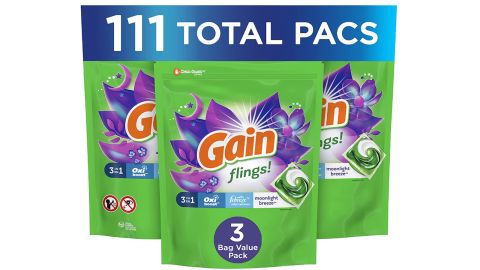CNN
—
If you’re new to doing laundry, it can be hard to know where to start. There are washer settings to understand, an overwhelming number of detergent options and stains that need to be treated — whatever that even means!
What “stain treatment” even means, as well as which detergents and wash cycles to use, are essential parts of understanding the basics of how to do laundry. In this guide, we’ll cover those topics, as well as how to gather and separate laundry, and the best way to dry clothing to prevent damage. Even if you’re an old hand when it comes to wash day, you might learn about an approach to laundry you hadn’t considered, or discover a trick you never knew about. So stick around! We’ll have some fun. (Really!)

The first step to doing laundry is to make the choice to do laundry — there are typically three triggers driving the choice:
- It’s a designated laundry day.
- The laundry hamper is overflowing.
- You find yourself wearing a bathing suit as underpants.
Rachel Hoffman, a cleaning and organizing expert and the author of Unf*ck Your Habitat and Cleaning Sucks, specializes in helping people who find cleaning overwhelming establish systems for household tasks; she offers this simple but very helpful advice for managing laundry: “Do laundry at regular intervals. For some people it’s once a week, for others, it’s more.”
If you’re a person who uses the hamper to signal that wash day has arrived, a lidded model is a smart choice because it will keep you honest — when the lid won’t close, it’s time to do the laundry.
BirdRock Home Laundry Hamper with Lid and Removable Liner

A divided hamper allows you to separate laundry as it goes into the hamper, rather than having to paw through a huge pile of dirty clothes on laundry day to separate lights from darks, or clothes from towels.

Historically, the way in which laundry was separated was straightforward: Whites and light-colored items went in one load, darks in another. This rule was driven by two primary factors, wash water temperature selection and dye transfer concerns. While dye transfer — i.e. dye from dark or brightly colored garments running in the wash and staining white or light colored ones — is still a concern, water temperature is no longer much of a factor.

“Most laundry can now be done in cold water. That should be the default,” Brian Sansoni, the senior vice president for communications of the American Cleaning Institute, says. “It’s usually just as effective, but it’s more sustainable and [using cold water will] reduce wear and tear or fading.”
Separating the wash by color is still the default, but a newer way to think about separating your wash is by fabric type. Modern fabrics that contain stretch, or have sweat-wicking properties, should not be washed with overly linty fabrics like terry cloth, heavy cottons or fleece. Figuring out how to keep linen, wool and athleisure can also mean that you might need to wash certain items by hand. Given that, these days many laundry-doers choose to separate clothes into one load, and sheets and towels into another, regardless of color.
If you do opt to wash darks and lights together, and dye transfer is a concern, use an in-wash color catcher to capture any loose dyes before they can stain lighter colored items.

While separating the wash, you will also want to set aside anything that needs to be laundered in a protective mesh bag; this can include items like robe sashes or shoelaces that need to be bagged in order to prevent them from winding around everything else in the wash, or things like bras that have hooks that can snag other items and become bent.

Stains on laundry should be pretreated prior to washing; a good time to do this is when you’re separating the wash. (An even better time to do this is before putting a piece of dirty laundry in the hamper; storing stain removal products by the hamper makes this a cinch.)

Unfortunately for laundry-doers everywhere, there is no single universal stain remover and here’s why: Stains have different chemical makeup — for example, chocolate stains are, chemically-speaking, totally different from sweat stains.
Most people will not need stain removers for every possible stain, though having more than one type of stain remover on hand isn’t a bad idea. The trick is to consider what type of stains your clothes etc. are most often afflicted by, and to stock stain treatment products accordingly. These are some of the best options for removing the most common types of stains.
Best for food and drink stains

Best for oils and grease stains

Best for protein stains and body soils

Best for ink, dye and makeup stains

Best for red wine, cranberry, pomegranate, blueberry and coffee stains

There are, it seems, 10,000 different types of laundry detergent on the market, and figuring out which one to use, not to mention how exactly to use it, can be daunting. We could be here all day talking about detergents (trust me when I say this, as I am a graduate of something called “Laundry School” and I even have the diploma to prove it!) but for now, just the basics will do.

There are three primary types of laundry detergent: Powder detergent, liquid detergent and detergent packs or pods. They all work, and so opting for one formula over another is a matter of personal choice. In broad terms, these are the reasons why you might choose one type of detergent over another.
There are three advantages liquid laundry detergent has over its counterparts. The first is that it dissolves better in water, regardless of temperature. The second is that it can do double duty as a pre-treatment for stains. The third is that, because it dissolves more easily in water, it’s the choice of detergent when it comes to hand-laundering.

Depending on the design of your washing machine, liquid detergent will either go into a compartment, which will release the soap at the right time in the cycle, or directly into the drum of the machine. If you have a compartment-style washer, one compartment should be designated for liquid products and another for powder products; do not commingle the two in a single compartment to prevent clumping and clogging.
Powder laundry detergent: The budget- and eco-friendly option
Because it does not contain water, powdered laundry detergent is more shelf stable, and requires less packaging than liquid detergent. Powdered laundry detergent is slower to lose efficacy, allowing you to buy in bulk for cost savings, and because there is less packaging involved, it is also the more environmentally-friendly choice.
Arm & Hammer Powder Laundry Detergent

As with liquid detergent the design of your washing machine will dictate how powder detergent is added to the machine.
Detergent packs are the best option for people who do their laundry outside the home (i.e. at a laundromat or in a shared laundry room) because it is much more convenient to toss a detergent pod in your bag of dirty laundry than it is to lug along a separate bottle of detergent.
Detergent packs, however, have some drawbacks. They are more expensive, per load, than liquid or powdered detergents. And, because they’re pre-portioned, they don’t allow you to control the amount of detergent being used; using more detergent than is necessary leads to product buildup that can cause clothing to retain odors even when clean, and lend a dingy appearance to garments.

Unlike liquid and powder detergents, detergent packs or pods should always be placed directly in the drum of the washing machine. Add the detergent pack prior to loading the machine with dirty laundry.
Cycles settings on washing machines generally control three factors: 1. water temperature; 2. cycle length; and 3. cycle speed.
Water temperature refers to cold, warm or hot options. To reiterate Sansoni’s guidelines, cold water should be the default for all laundry.
Cycle length determines how long washing will be. Use longer cycles for heavily soiled and bulky items, and shorter cycles for less soiled or delicate items.

Cycle speed refers to the speed and force at which laundry is agitated in the washing machine; use slower speeds for delicate items and faster ones for bulkier or more heavily soiled items.
Cycles on washing machines go by different names, but typically you will find one called “regular,” another called “permanent press” and a third called “delicates.”
The regular cycle is actually a misnomer, as it is the one you will be least likely to need. A regular cycle is fast/fast, meaning that both the washing and the spin cycles are fast. Use this for bulky items like towels, or very heavily soiled ones like outdoor work clothes.
Permanent press is the cycle you will most often need to use. It is fast/slow, meaning that the wash cycle is fast but the spin cycle is slow, and it is the best choice for most clothing, as well as for sheets.
The delicate cycle is slow/slow, and should be used when washing fine or delicate fabrics, or items with embellishments.
When the washer cycle is complete, remove laundry from the machine as soon as possible. Laundry can either be air dried (indoors or outdoors) or machine dried.
“If it’s a nice day, drying on a line, out of direct sunlight, is a good option,” Sansoni says.

If outdoor line-drying isn’t an option for you, but your laundry room or another space in the home allows for it, you might also consider indoor line-drying, as air-drying will better preserve fibers, colors and elasticity than machine drying will.

Machine drying, however, will probably be the best option for most laundry-doers. Choose the shortest and coolest cycle appropriate for the items you’re drying to avoid damage caused by over-exposure to high heat. Sansoni recommends using the dryer’s moisture sensor feature, if your machine has one, as it is a good way to prevent over-drying, which can cause fading, shrinkage and a weakening of fibers.

Two ways to speed up machine drying time, and to reduce the amount of heat your laundry is exposed to, is to shake garments out when transferring them from the washer to the dryer, rather than tossing them in a wadded up wet heap into the dryer, and to use dryer balls. Dryer balls, which come in wool and plastic styles, decrease drying time by creating better air circulation and preventing fabric clumping.


When clothes or linens are dry, remove them from the line or the dryer and fold them immediately to prevent wrinkling. Then, put them away.
Yes, that is part of doing laundry too.

